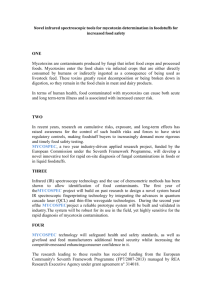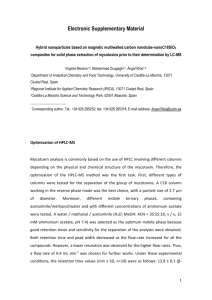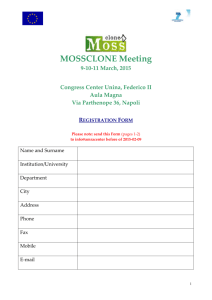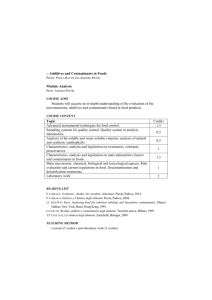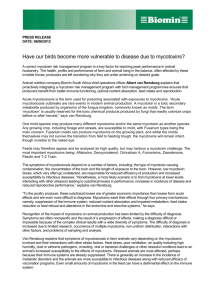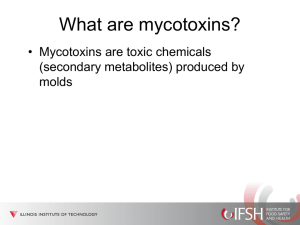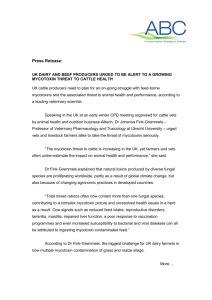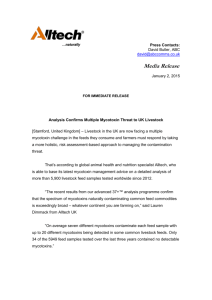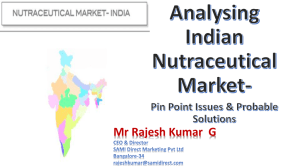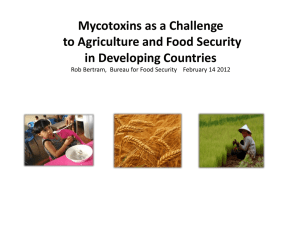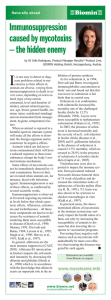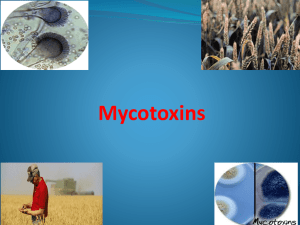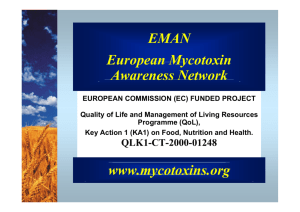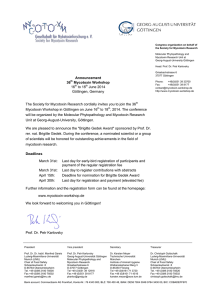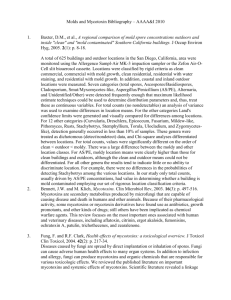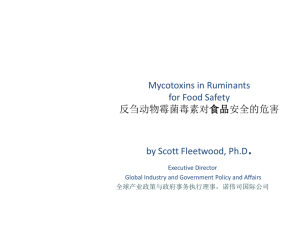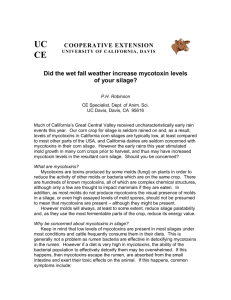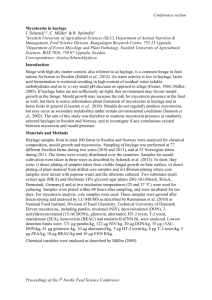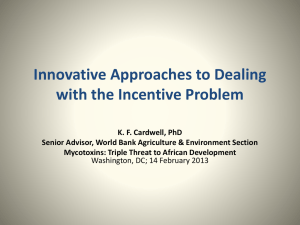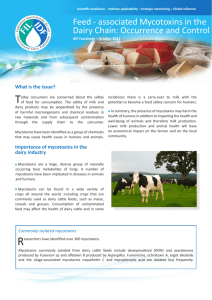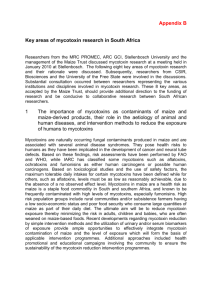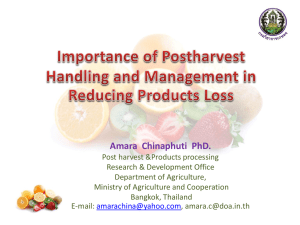Mycotoxin in Nutraceuticals and Functional Foods
advertisement
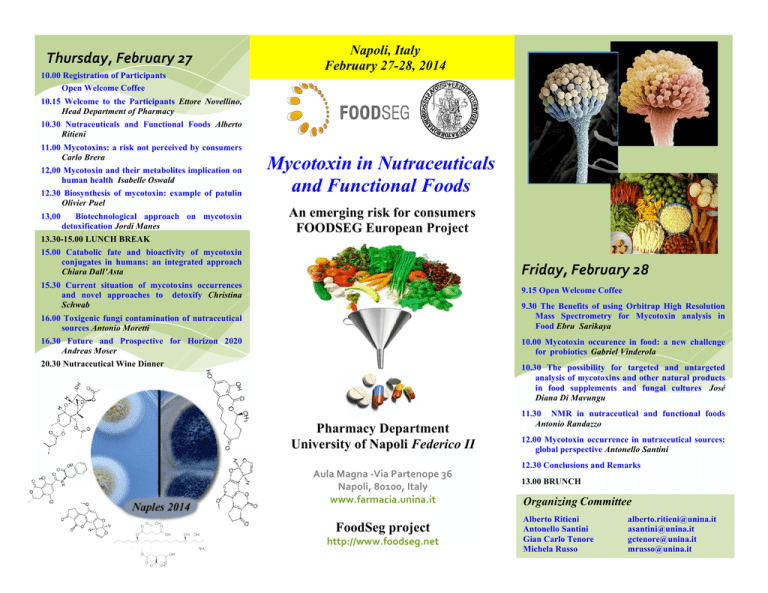
Thursday, February 27 10.00 Registration of Participants Open Welcome Coffee Napoli, Italy February 27-28, 2014 10.15 Welcome to the Participants Ettore Novellino, Head Department of Pharmacy 10.30 Nutraceuticals and Functional Foods Alberto Ritieni 11.00 Mycotoxins: a risk not perceived by consumers Carlo Brera 12,00 Mycotoxin and their metabolites implication on human health Isabelle Oswald 12.30 Biosynthesis of mycotoxin: example of patulin Olivier Puel 13,00 Biotechnological approach on mycotoxin detoxification Jordi Manes 13.30-15.00 LUNCH BREAK Mycotoxin in Nutraceuticals and Functional Foods An emerging risk for consumers FOODSEG European Project 15.00 Catabolic fate and bioactivity of mycotoxin conjugates in humans: an integrated approach Chiara Dall’Asta Friday, February 28 15.30 Current situation of mycotoxins occurrences and novel approaches to detoxify Christina Schwab 9.15 Open Welcome Coffee 9.30 The Benefits of using Orbitrap High Resolution Mass Spectrometry for Mycotoxin analysis in Food Ebru Sarikaya 16.00 Toxigenic fungi contamination of nutraceutical sources Antonio Moretti 16.30 Future and Prospective for Horizon 2020 Andreas Moser 20.30 Nutraceutical Wine Dinner 10.00 Mycotoxin occurence in food: a new challenge for probiotics Gabriel Vinderola 10.30 The possibility for targeted and untargeted analysis of mycotoxins and other natural products in food supplements and fungal cultures José Diana Di Mavungu Pharmacy Department University of Napoli Federico II Aula Magna -­‐Via Partenope 36 Napoli, 80100, Italy www.farmacia.unina.it FoodSeg project http://www.foodseg.net 11.30 NMR in nutraceutical and functional foods Antonio Randazzo 12.00 Mycotoxin occurrence in nutraceutical sources: global perspective Antonello Santini 12.30 Conclusions and Remarks 13.00 BRUNCH Organizing Committee Alberto Ritieni Antonello Santini Gian Carlo Tenore Michela Russo alberto.ritieni@unina.it asantini@unina.it gctenore@unina.it mrusso@unina.it Mycotoxin risk in Nutraceutical and Functional Foods Feed and food are crucial and critical for the health related possible conditions that imply the possible onset of debilitating chronic diseases with a very high social and economic impact. The new horizon ahead is the Nutraceuticals and the Functional Foods. These are concentrates of active molecules from vegetal sources and can provide both prevention and support to pharmaceutical therapy. Nutraceuticals safety and the possible mycotoxin contamination assessment are a new challenge for the future. The possible mycotoxins contamination in raw materials and/or in transformed foods is a serious risk. The botanical origin of many of these plants originating from areas at risk of mycotoxins occurrence and the processes of extraction and concentration of the active principles represent some of the critical points to be monitored to provide, safe and “mycotoxins free” nutraceutical and/or functional food. Mycotoxins and Nutraceutical Sources Mycotoxins are a serious threat to human health, especially for the underestimation of the risk associated with their presence in the food chain. The mycotoxins chemicalphysical characteristics make them coextractable during the preparation of nutraceuticals and functional ingredients for the so-called "novel food". Mycotoxins are mainly involved in the aetiology of numerous diseases of the gastro-intestinal tract and their chemical reactivity makes them a challenging area of study to assess new functional activities potentially related to the "novel foods". Partecipants: C. Brera - Istituto Superiore Sanità, Roma C. Dall’Asta - University of Parma J. Diana Di Mavungu-Ghent University, Belgium J. Manes - University of Valencia, Spain A. Moretti - CNR, Italy A. Moser - RTD Service, Austria I. Oswald - INRA, France O. Pouel - INRA, France G. A. Randazzo - University of Napoli Federico II A. Ritieni – University of Napoli Federico II A. Santini - University of Napoli Federico II E. Sarikaya - Thermo Fisher, Italy C. Schawab, Biomin, Austria G. Vinderola - CONICET, Argentina
